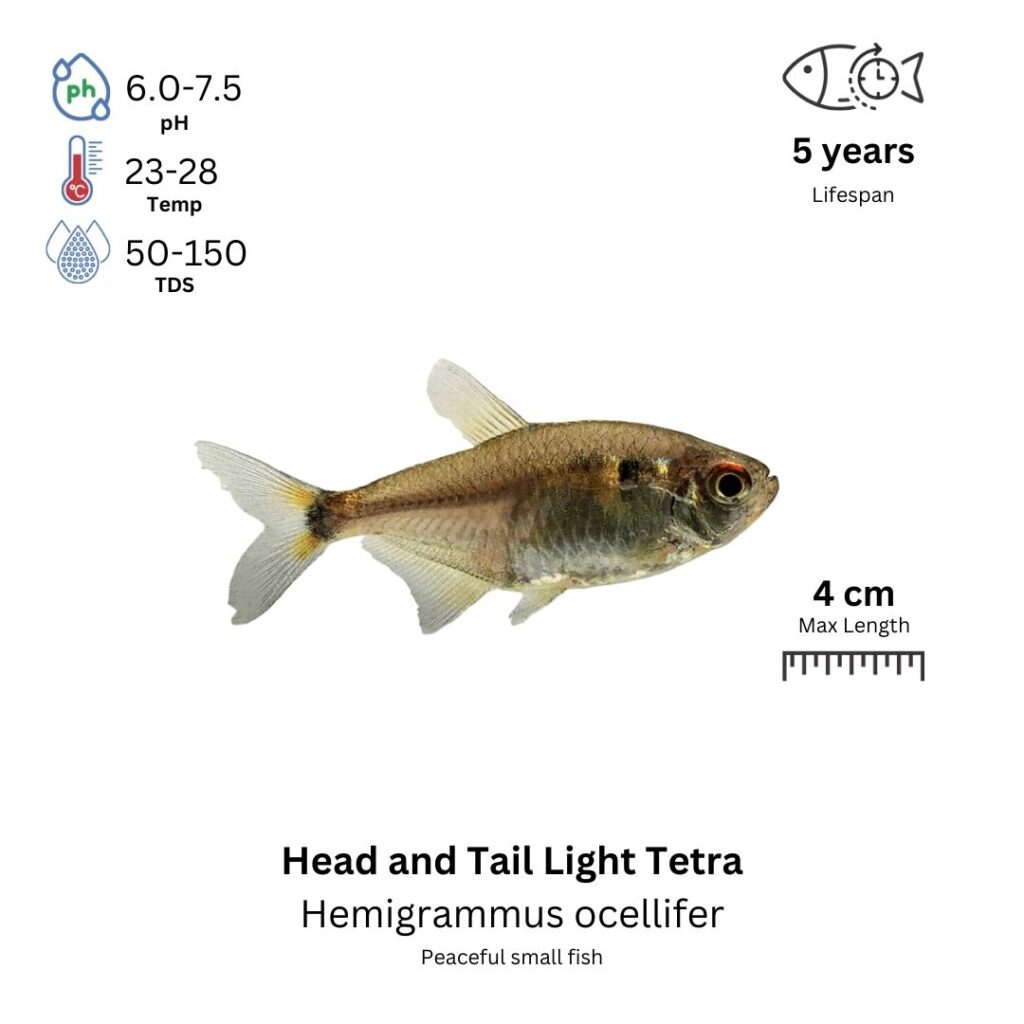Head and Tail Light Tetra
Hemigrammus ocellifer

Description
The Head and Tail Light Tetra is a small and beautifully patterned fish, known for its distinctive appearance and peaceful nature. The body is translucent with a pale silver coloration, and it features two characteristic bright spots: one at the head, around the gill area, and another at the tail, giving it its common name. These spots appear as bright, reddish-orange or yellow, resembling “headlights” at both ends of the fish. The males tend to be slightly more colorful and active than the females, but both sexes display these striking markings. The fins are delicate and transparent, with a subtle tint of color.
Habitat Origin
Native to the slow-moving, clear rivers and streams of South America, particularly in regions of the Amazon River basin in Brazil and surrounding countries. These fish inhabit areas with dense vegetation, submerged rocks, and organic debris, where they seek cover and feed on smaller invertebrates and plant matter. In their natural habitat, they are accustomed to slightly acidic to neutral water conditions, and they thrive in well-oxygenated, clean environments.
Aquarium
Ideal Number in Aquarium: At least 6 individuals, as they are schooling fish and feel more secure in groups.
Favorite Food

Head and Tail Light Tetras are omnivores and will accept a variety of foods. They can be fed high-quality flake food, micro pellets, and live or frozen foods such as brine shrimp, daphnia, and bloodworms. They also enjoy small plant matter and algae, so incorporating vegetable-based foods like spirulina or blanched zucchini will benefit them. A varied diet ensures they stay healthy and maintain their vibrant coloration.
Behavior:
Head and Tail Light Tetras are peaceful, social, and active fish. They thrive in schools and are often seen swimming together in the middle to upper levels of the aquarium. These fish exhibit schooling behavior, making them an excellent addition to community tanks where their glowing markings can be admired. They are generally calm and non-aggressive but may become slightly territorial during breeding or when competing for food. It’s best to house them with other small, peaceful fish to reduce stress and promote natural behavior.
Special Care:
Head and Tail Light Tetras are easy to care for but thrive best in stable water conditions. Regular water changes and good filtration are important for maintaining water quality. These fish prefer a well-planted tank with plenty of hiding spaces where they can feel secure. They are best kept in schools to reduce stress and encourage their natural behavior. Providing soft, slightly acidic to neutral water will ensure they thrive. They are hardy but may become stressed or lose their bright colors if kept in poor water conditions or without the company of their own kind.
Compatibility with Other Fish:
Yes, Head and Tail Light Tetras are compatible with a wide range of peaceful fish species. They can be housed with other small, non-aggressive species such as rasboras, small cichlids, and catfish. They are also safe to keep with shrimp and snails. Larger, more aggressive fish should be avoided, as they may intimidate or harm the tetras. These fish do best in peaceful community aquariums with other small species that occupy different areas of the tank.
Breeding Tank Setup
Establishing a dedicated breeding tank for Head and Tail Light Tetras is essential for maintaining ideal water parameters and protecting eggs and fry from potential predation. A 40-liter (10-gallon) aquarium is optimal, providing enough room for a small breeding group while simplifying water management. Ideal water conditions include slightly acidic to neutral pH (6.0–7.5), temperatures of 24°C to 28°C (75°F–82°F), and soft to moderately hard water (5–12 dGH). Use a gentle sponge filter or low-flow internal filter to avoid strong currents that can stress the fish or disrupt spawning. Incorporate fine substrates such as sand or smooth gravel, along with live plants like Java moss, Hornwort, Anubias, and floating plants like duckweed, creating natural egg-laying sites and shaded areas. Moderate lighting, similar to their naturally shaded habitats, encourages comfortable spawning behavior.
Conditioning for Breeding
Preparing Head and Tail Light Tetras for spawning involves providing them with a high-quality, protein-rich diet. Feed them a varied diet, including specialized tetra pellets, supplemented with live foods such as brine shrimp, daphnia, bloodworms, and frozen alternatives. Regular water changes (approximately 25% weekly) are essential for maintaining pristine water conditions, thereby promoting overall health and stimulating spawning readiness.
Spawning Process
Head and Tail Light Tetras exhibit egg-scattering spawning behaviors. Males court females through vibrant displays, showcasing distinctive bright spots on their heads and tails, followed by chasing behaviors. Females typically scatter between 50 and 200 sticky eggs onto available surfaces like plants, substrate, or aquarium walls, which males fertilize immediately afterward. To maximize egg survival, it is advisable to remove adult fish from the breeding tank after spawning, as adults may consume the eggs.
Fry Care
Eggs generally hatch within 24–48 hours, influenced by water temperature. Initially, fry depend on their yolk sacs for nutrition until they become free-swimming. Once actively swimming, provide them with infusoria, microscopic algae, or specialized liquid fry food. After a few days, transition to feeding them baby brine shrimp or similarly sized live foods, gradually introducing finely crushed flakes or small pellets as the fry grow. Ensuring excellent water quality through daily 10–15% water changes, stable temperatures (24°C–28°C), and regular monitoring of ammonia, nitrite, and nitrate levels is crucial for healthy fry development.
Important Breeding Notes
Head and Tail Light Tetras typically reach sexual maturity between 6 to 12 months of age; breeding should ideally commence once they are fully mature. Males are characterized by smaller, slimmer bodies with vibrant colors and noticeable bright spots during courtship, whereas females are generally larger and visibly rounder when gravid with eggs. Minimizing stress by ensuring stable water parameters, preventing overcrowding, and excluding aggressive tankmates greatly enhances breeding success. Sudden environmental changes or poor water quality can adversely affect spawning behavior and egg viability.
